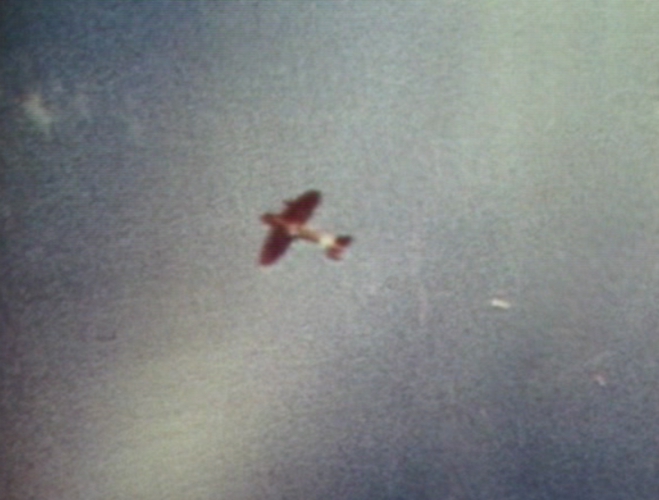
| Caption | D3A1 carrier dive bomber in flight over Sand Island, Midway Atoll, 4 Jun 1942 ww2dbase | |||||||||||
| Photographer | John Ford | |||||||||||
| Source | ww2dbaseUnited States Navy | |||||||||||
| More on... |
| |||||||||||
| Photo Size | 659 x 500 pixels | |||||||||||
| Photos on Same Day | 4 Jun 1942 | |||||||||||
| Photos at Same Place | Midway, US Pacific Islands | |||||||||||
| Added By | C. Peter Chen | |||||||||||
| Licensing | Public Domain. According to the United States copyright law (United States Code, Title 17, Chapter 1, Section 105), in part, "[c]opyright protection under this title is not available for any work of the United States Government". Please contact us regarding any inaccuracies with the above information. Thank you. |
Did you enjoy this photograph or find this photograph helpful? If so, please consider supporting us on Patreon. Even $1 per month will go a long way! Thank you. Share this photograph with your friends: Stay updated with WW2DB: |
Visitor Submitted Comments
2.  Bill says:
Bill says:
16 Oct 2016 07:02:35 PM
TWIST & TURN: GONNA BE A FLAMMER
Looks like this Val is inverted
and trying to evade those .50 caliber rounds fired from a US fighter. Like most
Japanese aircraft, the Aichi D3A "Val" had no armor protection for the crew or fuel tanks.
Most US pilots used what is called deflection shooting, that is shooting just a head of the target, so the slugs meet the aircraft at the same time.
The lightly armed D3A "Val"
had 2 x 7.7mm machine guns for the pilot and 1 x 7.7mm for the rear gunner still not enough to duke it out with a fighter...
16 Oct 2016 07:02:35 PM
TWIST & TURN: GONNA BE A FLAMMER
Looks like this Val is inverted
and trying to evade those .50 caliber rounds fired from a US fighter. Like most
Japanese aircraft, the Aichi D3A "Val" had no armor protection for the crew or fuel tanks.
Most US pilots used what is called deflection shooting, that is shooting just a head of the target, so the slugs meet the aircraft at the same time.
The lightly armed D3A "Val"
had 2 x 7.7mm machine guns for the pilot and 1 x 7.7mm for the rear gunner still not enough to duke it out with a fighter...
All visitor submitted comments are opinions of those making the submissions and do not reflect views of WW2DB.
Search WW2DB
Modern Day Location
| WW2-Era Place Name | Midway, US Pacific Islands |
| Lat/Long | 28.2014, -177.3814 |
Random Photograph
Current Site Statistics
- » 1,150 biographies
- » 337 events
- » 43,917 timeline entries
- » 1,241 ships
- » 350 aircraft models
- » 207 vehicle models
- » 375 weapon models
- » 123 historical documents
- » 260 facilities
- » 470 book reviews
- » 28,546 photos
- » 432 maps
Famous WW2 Quote
"Goddam it, you'll never get the Purple Heart hiding in a foxhole! Follow me!"Captain Henry P. Jim Crowe, Guadalcanal, 13 Jan 1943
Support Us
Please consider supporting us on Patreon. Even $1 a month will go a long way. Thank you!
Or, please support us by purchasing some WW2DB merchandise at TeeSpring, Thank you!
20 Jul 2015 07:00:36 PM
CANNON FODDER:
At the start of the Pacific War, Japanese aircraft
were lightly built and lacked armor protection for crew and fuel tanks. Once Allied pilots started to use new tactics against these aircraft Japanese losses started to mount.
It was a master that could avoid being shot down and live to fight another day. Short bursts from the heavy US .50 Caliber machine gun round, would be enough to rip into the wings and fuselage, this would break up the aircraft or turn it into a flaming torch.
LOSSES MOUNT: ONLY THE VERY, VERY BEST
As the war continued most of Japan's veteran crews were killed or wounded in battle and replaced with men that in pre-war Naval Pilot Training, would have been rejected. This wasn't due to their lack of flying skill or the academic training needed, the Imperial Navy couldn't keep up with the losses and didn't have a second-line pool of trained pilots.
Veteran pilots that survived the air battles were later needed as flight instructors were far to few.
Everything was up front and only the very, very best were taken for pre-war pilot training. Did you know that during WWII Japan produced almost 80,000 aircraft, while the United States produced over 300,000 aircraft. Japan was out produced and was able to train pilots faster than Japan.